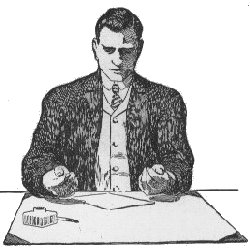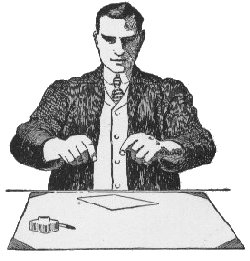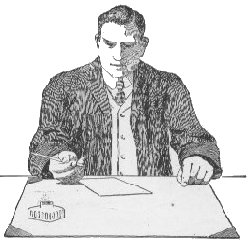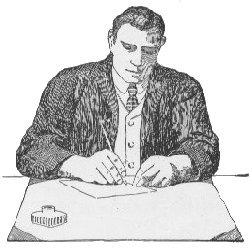 Author of the Palmer Method of Business Writing and Editor of the Western Penman. I HAVE thought best to evade the historical, the obsolete and non-practical part of chirography, and deal only with the live, up-to-date, utilitarian phases of writing, the issues that will appeal directly to young men and women who seek training that will fit them for the practical business life, where rapid, legible penmanship is even more in demand than before the advent of the typewriter and the art of shorthand. Shorthand and typewriting may have supplanted longhand writing in some directions, but they have emphasized the necessity of legibility and speed in other directions. The man who hires a stenographer will pay a higher salary to one who can write a good business style of longhand than he will pay to one who simply scribbles, and the reason is self-evident. In very few offices are stenographers relieved from all writing of longhand. Records are to be kept, addressing and many other things about a well-managed office are done, which can be more conveniently done with pen and ink than with the typewriter. No young man or woman, regardless of the vocation chosen, will regret the short time necessary to spend in mastering a good style of business writing. Under modern methods the process is not only short, but it is easy, and to the majority a delightful pastime. Under the old regime we might fittingly exclaim with Will Carleton: Oh, pen, when in the old time school-house we That was when everything in penmanship instruction tended toward one end only, accuracy; accuracy without ease, and accuracy without speed, a slow drawing style in which the fingers were the chief, if not the sole, agents of execution. This, the copybook plan, still quite largely in use in public schools, developed a style of penmanship that was good only when the execution was slow, and when but little writing was required. The outcome, in fact, was a retrogressive tendency as soon as an attempt was made to apply speed, and when continuous writing was demanded. The copybook mode of instruction has always led to poor, rapid continuous writing; indeed, I might say, to scribbling. In fact, any plan of penmanship instruction in which the large tireless muscles of the arm are ignored can lead to only one end—poor, erratic writing, and perhaps writer's cramp when much and continuous writing is required. The student who desires to master a good commercial style of penmanship in the shortest possible time, should give careful attention to the cultivation of the muscles of the arm, and the movement from these muscles. Muscular movement should receive more attention on the start than the forms of letters. Latent in the arm of every boy and girl and man and woman of whatever age, providing the faculties are well preserved, is an easy, free movement that may be developed and applied to good writing within an almost incredibly short time if the right methods of training are followed. The successful plan is to study the muscles of the writing arm closely, gaining some control of them and ascertaining their functions before attempting to do much writing, or any good writing. Good writing—the result of good movement and muscular control—will closely follow. Do not attempt to practice penmanship with poor paper, poor pens, or poor ink. Good material is an absolute necessity. Do not use a metal finished penholder. A rubber finished "Crown" and cork finished "Bank" are among the best penholders made. Never use an oblique penholder in business writing. It is out of place and of no advantage whatever. There is nothing that equals an oblique holder for ornamental writing, but there its utility ends. Use paper of generous size for your practice, a medium coarse pen and good blue-black writing fluid. As the movement taught is one in which the muscles of the right forearm play an important part, it is highly essential that these muscles should be so clothed as to permit, at all times, unrestricted action. Many good writers consider this of sufficient importance to lead them to cut off the right undersleeve at the elbow. The muscular movement, as applied to writing, is the movement of the muscles of the arm from the shoulder to the wrist, while keeping the larger part of the arm forward of the elbow on the desk, the fingers not being held rigidly, but remaining passive, and not being extended or contracted in the formation of any of the capitals or any of the small letters except the upper loops, when there may be a slight extension and contraction in making the turn at the top. In this movement the propelling power is located behind the elbow in the upper muscles of the arm.  Examine your right arm. Notice the increasing size from the wrist to the elbow. Grasp the right arm with the left hand just below, but near the elbow. Note particularly the elasticity of the muscles; move the flesh on the right arm forward and backward with the left hand. On the development of the elasticity of that muscle depends your success in learning a good style of business writing. You are urged to read the above a number of times. It is important. Throw your right arm on the desk and close the fingers of the right hand tight (see accompanying cut). See how far you can move the hand forward and backward without slipping the sleeve or without any motion of the wrist or fingers. The fingers must be closed so that you cannot extend or contract them.
The purpose of illustrations 1 and 2 is to show the natural positions of the fingers that should be maintained in writing. Throw your arms on the desk in a natural position, such as you would take if you were simply resting and not contemplating using a pen; turn the palms of the hands upward, as shown in cut 1, and study the position of the fingers. Now turn the palms downward and raise both arms from the table, as shown in cut 2, the left hand being a little in advance of the right; drop both arms to the table and you will be in a good writing position. But let us go further. Study closely the position of the right hand in illustration 3. Note the fact that the fingers have not been changed from numbers I and 2 beyond what was necessary to hold the penholder firmly. The penholder rests against the side of the second finger, at the root of the nail; the first finger rests on the upper part of the holder, and the thumb rests against the side of the holder at the lower joint of the first finger. Notice further the relative position of every part of the holder with the hand. Now pass on to illustration 4. Here we have a good position for executing writing rapidly and easily on the regular slant. The right arm is thrown well out from the side and a right angle (turn) is formed at the elbow; the third and fourth fingers are thrown well under the hand, forming a movable rest; the side of the hand and wrist, while near the paper, does not touch it; the penholder points a little to the right of the right shoulder; the left hand is at the upper left corner of the paper, keeping it in position; the body, while bending slightly at the hips, is self-supporting, and the large muscles of the forearm rest on the desk, the fulcrum or main rest being just forward of the elbow. Before going any further, experiment with position. Move the hand forward and backward, right and left, round and round, without extending or contracting the fingers holding the pen, and with the pen raised from the paper.
Drills 1-9 |



